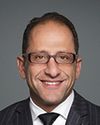Good afternoon. My name is Randall Baran-Chong. I’m an entrepreneur from Toronto, hence why I wanted to articulate myself through a PowerPoint.
I'm here to represent Canadian SIM-swap Victims United, a grassroots organization of victim advocates from across Canada and across all walks of life, formed as a result of what’s described as one of the phone frauds that experts fear most. As victim advocates, we take our harrowing experience into hope for greater awareness, combine that with expert advice, and engage industry and leadership like you to promote action, with the sole objective of not adding another name to our roster.
Though my story starts back at the end of October 2019, this really begins back in 2007, with one of your former colleagues, Maxime Bernier, minister of industry at the time, announcing wireless network portability. In essence, what that was all about was to provide consumers the power to essentially vote with their dollars in terms of moving from carrier to carrier without being encumbered by losing their number.
It was all about empowering consumers and their choice to go to the carrier they wanted, but while well intended—like the road to hell, it was paved with good intentions—it led to the hell that many of us victims know as the SIM swap scam, also known as the unauthorized customer transfer or unauthorized porting. What that essentially describes is the transfer of someone's phone number from their own SIM to another SIM without the authorization of the account holder.
Let's dissect generally how SIM swapping works. The vast majority of SIM swaps are financially motivated. These fraudsters begin by doing their homework to gather the goods. What I'm referring to is the fraudsters getting a real understanding of who these victims are at a personal level and trying to find some identifiers about them, but really, if they're trying to do it through an unauthorized porting, they want to get the key pieces of information that are required to execute the port. These are, first, the phone number itself, and then one of the following, as described by the Wireless Network Portability Council, which has defined these rules: the account number of the holder, the device ID or a PIN. If you think about it, you only need the phone number plus one of those identifiers, and the phone number is highly accessible for most of us, so you already have half the job done.
How do you get the rest of it? This is where the methods of these fraudsters take place.
One of the major methods they use is social engineering, which means taking advantage of the human fallibility of the customer service reps. Oftentimes, they'll pretend: “I'm the customer, I lost my phone, I desperately need to get a phone back.” They'll play the system. They might even say that they forgot their PIN and will provide other types of information that are even more accessible, such as postal code or maiden name and things like that, to get around it and get access to the porting information.
They'll use phishing, fake phone numbers or fake emails purporting to be from Rogers and saying to enter your account number, but it's really the hacker who is getting your information. They can also use social media to find personal information about the person and, recently, even through data leaks. Telus and its flanker brand Koodo announced that their customers from 2017 and prior had their account information compromised by an unauthorized user, and they all had to get port protection put on their accounts.
Finally, and most nefariously, they have inside employees. This is something that we've seen in the United States, where employees at companies like AT&T and T-Mobile actually sold account information for $20 or less to these fraudsters.
That is how they execute the port.
Now that they have the information, what they'll often do is get a prepaid phone account. There's no identification required to get a prepaid phone because of PIPEDA; it's essentially untraceable to these people. Now that they have the information, they'll call and execute the port with that carrier and, under the CRTC decision from 2005, this has to be executed within 2.5 hours or less.
I saw on Tuesday that one of you got a CRA scam text, and I hope you never see on your phone that your SIM is no longer in service. That's how the victim finds out that they've been ported over. The victim has not really been involved. When I had mine happen, it was at 11:40 at night, and I suddenly saw that my phone was no longer working. I thought it was technical, but it turns out that I was being ported.
From that point forward, any calls that are outbound or inbound—texts, anything like that—are in the possession of the fraudsters themselves. For this next stage, which we call “forget it and reset it”, I'm sure many of you have text-based factor authentication with your social media accounts, bank accounts and things like that. If you forget your password, you click on “I forgot my password”, and it will send you a text for a one-time password to reset your password. Then, essentially, they can redefine the password.
Now that the fraudster has your phone number, they are receiving those texts or calls, and they are going in and locking you out of your very own account. It then comes to the plundering. Oftentimes, these fraudsters will work in teams to create this havoc. It manifests itself when you see emails flooding into your inbox saying that your account password has been changed and a new contact has been added to your account, and all you can do is watch.
In my particular case, which happened at night, as I've mentioned, I called my carrier and was told, “Thank you for calling customer service. Our hours are from 8 a.m. to 8 p.m., Monday to Friday.” They put up a 12-hour defence for an enemy that fights a 24-hour war. To get the phone number back, it oftentimes takes several hours or, in some of the cases we've seen, up to a few days.
How is the damage done? There are three key ways in which they try to take advantage of this. One is the direct theft. In particular, crypto is a flavour they prefer, because it's very hard to trace them afterwards, but there are average victims, such as the Johnson family of Peebles, Saskatchewan, who lost hundreds of thousands of dollars from their farm account. Others take advantage of the apps that have credit cards linked to them, as in the case of nurse Sheila O'Reilly from Oakville.
In my case, they tried to extort and blackmail me. They got access to my cloud drive. Essentially, as a small business person, with my small business account and my personal account all being on this cloud drive, five years of my life are now in someone else's hands. I told this story to someone in the United States who lost a million dollars—90% of his life savings—and he said, “Your offence that you had against you was much worse.” He feels bad for me.
Oftentimes what they'll do is take this data and monetize it on the dark web for the low low low price for log-in credentials of $20 to $120 and to $3,000 for full identification. In other cases, they will take over accounts. Jack Dorsey, for example, the founder of Twitter...if the founder of Twitter can be a victim of a crime like this, who amongst us is safe? Even celebrities such as Mariah Carey and Adam Sandler have been victims of this. In other cases, they target accounts that have desirable user names. There's a man in Toronto named Jack Hathaway, who lost his Instagram handle “cosplay”, which is a highly valued target.
Unlike things like phone spoofing or these other frauds that you heard about earlier, these aren't necessarily done from call centres overseas that we feel we're helpless to take action on. As recently as November an arrest was made of an 18-year-old from Montreal who has participated in the theft of $300,000 from Canadians and over $50 million from Americans.
What this really demonstrates is that these aren't sophisticated programmers, hackers and coders who are doing this. These are the people who know how to play the game. These are commonly done—in the arrests that have been made in the United States, for example—by people under the age of 25.
We came to the realization that our phone numbers are our new form of identity. Our SIM is like our new SIN, and security is as strong as the weakest link, whether it's technical or human. Finally, when it comes to unauthorized porting, it can have lifetime impacts, so we need to change the way we think about these things.
How is it being dealt with elsewhere? In the United States, they're treating it as a national security risk. In places such as Africa, they're using co-operation between the banks and the telcos to identify fraud risk. In Australia, they have actually taken regulatory action to introduce pre-porting processes to identify whether or not you have actually validated the requests. They've even introduced buy-ins for telcos that don't comply with the authorized porting process.












